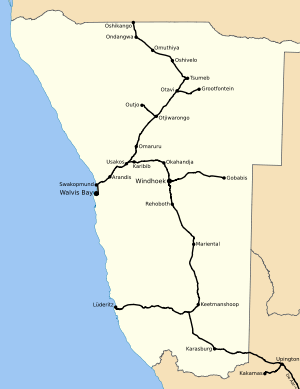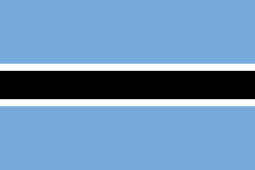Rail transport in Namibia

Rail service in Namibia is provided by TransNamib. Namibia's rail network consists of 2,382 route-km of tracks, however this number continues to increase as the rail infrastructure continues to grow.
Namibia has a history of more than 100 years of railway service. During the colonialisation by the German Empire between 1894 and 1915, a number of railways were built, some of which are still in service today.[1]
History

Early development
The building of German South West Africa's railways began with a small mining rail line at Cape Cross in 1895. The first major railway project was started in 1897 when the German Colonial Authority build the "Staatsbahn" (state railway) from Swakopmund to Windhoek. By 1902 the line was completed. Parallel to this government initiative the Otavi Mining and Railway Company (O.M.E.G.) was established which built a line from Swakopmund to Tsumeb via Otavi between 1903 and 1906, and a branch from Otavi to Grootfontein in 1907/08.[2]
The German colonial railway was taken over by the Railways of South Africa after World War I, and linked into the network of South Africa. After the independence of Namibia, TransNamib took control of the national rail network that operates on 3 ft 6 in (1,067 mm).
African Rail Conference
Plans to integrate the railways of Africa to facilitate trade were discussed at the Africa Rail conference in Johannesburg, South Africa in August 2002. The move forms part of the New Partnership for Africa's Development (NEPAD), a programme aimed at economic renaissance.
The railways were built by former colonial powers, but were not built to advance African interests. Plans were put into place to link the three parallel east-west lines in Angola and to connect the Angolan network to that of Namibia and hence to South Africa.
The strategic positioning of Maputo rail and port infrastructure indicated that the network should be promoted as the primary corridor serving Zimbabwe, Zambia, Democratic Republic of Congo, Swaziland, and South Africa's Mpumalanga province.
South Africa's transport minister, Mr Abdulah Omar, said Africa needed to integrate its railway systems to form an internationally-competitive network. Experts said this could involve leasing locomotives and wagons, becoming involved as concessionaires and consultants, and participating in joint ventures.[3]
Current Railway Lines
Windhoek-Kranzberg
The railway line from Windhoek to Kranzberg is 210 kilometres (130 mi) long and was completed in 1902.[1]
- Windhoek - capital - junction
- Okahandja
- Karibib - proposed cement works
- Kranzberg - junction Tsumeb v Windhoek.
Kranzberg-Walvis Bay
The railway line from Kranzberg to Walvis Bay is 201 kilometres (125 mi) long. The section between Kranzberg and Swakopmund was completed in 1902. In 1914 an extension to Walvis Bay was commissioned; the rails were laid close to the shore of the Atlantic Ocean. In 1980 this extension was replaced by an alternative route behind the dunes that allowed for higher axle load.[1]
- Kranzberg - junction Tsumeb v Windhoek.
- Usakos
- Arandis - crossing loop
- Swakopmund
- Walvis Bay - port
Kranzberg-Otavi
The railway line from Kranzberg to Otavi is 328 kilometres (204 mi) long and was completed in 1906.[1]
- Kranzberg - junction Tsumeb v Windhoek.
- Omaruru
- Kalkfeld - short siding
- Otjiwarongo - junction for Outjo
- Otavi
Otavi-Grootfontein
The railway line from Otavi to Grootfontein is 91 kilometres (57 mi) long and was completed in 1908.[1]
- Otavi - junction for Grootfontein
- Grootfontein - branch terminus.
Seeheim-Aus
The railway line from Seeheim to Lüderitz is 318 kilometres (198 mi) long. The connection between Lüderitz and Aus was completed in 1906, the extension to Seeheim was completed in 1908.[1] Currently the service between Aus and Lüderitz is decommissioned, and there is no regular passenger service between Seeheim and Aus. The line to Lüderitz was scheduled for reopening in 2017. But at the moment (July 2017) there is no official date for the reopening published.
- Seeheim - junction for Lüderitz
- Aus
 A bogie passing at railwaystation Simplon on its way from Seeheim to Aus. (25 April 2017)
A bogie passing at railwaystation Simplon on its way from Seeheim to Aus. (25 April 2017) Railwaystation Simplon between Sandverhaar and Goageb
Railwaystation Simplon between Sandverhaar and Goageb Luxury Passenger Train July 2015 at Simplon (Between Sandverhaar and Goageb)
Luxury Passenger Train July 2015 at Simplon (Between Sandverhaar and Goageb) New Railway lines near Kolmanskuppe (October 2015)
New Railway lines near Kolmanskuppe (October 2015)
Nakop-Windhoek
The railway line from Nakop to Windhoek is 869 kilometres (540 mi) long. The section between Karasburg and Keetmanshoop was completed in 1909. In 1912 the 500 kilometres (310 mi) connection between Karasburg and Windhoek was completed, and the extension to Upington (South Africa) was built in 1915.[1]
Otjiwarongo-Outjo
The railway line from Otjiwarongo to Outjo is 69 kilometres (43 mi) long. The first 26 kilometres (16 mi) were completed under the German colonial administration in 1914/1915; the railway line was named Amboland Railway in reference to the territory of the Ovambo people. The link to Outjo was completed in 1921 under South African rule.[1]
- Otjiwarongo - junction for Outjo
- Outjo - railhead
Windhoek-Gobabis
The railway line from Windhoek to Gobabis is 228 kilometres (142 mi) long and was completed in 1930.[1]
Otavi-Oshikango
In 2005, an 89 km section of new Northern Railway from Tsumeb to Oshivelo was opened by President Sam Nujoma, as part of the "Northern Extension" of the railway link from Kranzberg to Otavi. Construction on the project's second phase, a 59 km stretch from Ondangwa to Oshikango on the Angolan border at a cost of about N$329m, was scheduled to be completed by December 2007. Ondangwa Station opened in 2006 for freight.
In phase 3, a 58 km branch from Ondangwa to Oshakati was constructed at an estimated cost of N$220m, for completion in December 2008. For the future a connection from Oshikango to a point near Cassinga is planned on Angola's southern railway system.[4][5]
The Ondangwa-Oshikango line was officially opened by President Hifikepunye Pohamba in July 2012. In order to keep system operational and safe, provincial governor Usko Nghaamwa implored local residents to stop stealing railroad ties and sections of the wire fence.[6]
- Otavi - junction for Grootfontein
- Tsumeb
- Ondangwa - junction
- Oniipa road bridge.
- Onjdiva[5]
- Namacunde[7]
- Oshakati
-

 Oshikango - border post - current railhead[8]
Oshikango - border post - current railhead[8]
Historic Railway Lines
Apart from a number of short rail connections built by mining companies, the following railway links are decommissioned:
- 20 kilometres (12 mi) Cape Cross Mine Railway, 610 mm (2 ft) gauge. The first railway line in South West Africa, built in 1895/96.[1]
- 18 kilometres (11 mi) Walvis Bay Railway, 610 mm (2 ft) gauge, completed in 1899. The line linked the port of Walvis Bay to Rooikop.[1]
- 567 kilometres (352 mi) Otavibahn, a 600 mm (1 ft 11 5⁄8 in) private railway built by the Otavi Mining and Railway Company between 1903 and 1906 to connect the mines at Tsumeb to the town of Swakopmund. In 1908 the line was extended by 91 kilometres (57 mi) to reach Grootfontein.[1] The Otavibahn was the longest 600 mm (1 ft 11 5⁄8 in) gauge railway in the world at its time of construction.[9]
- 119 kilometres (74 mi) a 600 mm (1 ft 11 5⁄8 in) industrial line linking Kolmanskop with Bogenfels, completed 1913.[1] This was the only rail link in Namibia ever electrified. The rail track does not exist anymore.
- 26 kilometres (16 mi) Amboland Railway, Otjiwarongo - Outjo, 1914-1915.[1]
Proposed Railway Lines
Trans-Kalahari Coal Line
- Gobabis - current railhead[10]
-

 Buitepos - border post
Buitepos - border post -
 Mamuno
Mamuno -
 Mmamabula - coal deposits
Mmamabula - coal deposits -
 Lobatse, Botswana - current railhead[11]
Lobatse, Botswana - current railhead[11]
Zambia-Namibia link
- Zambia - Grootfontein[12]
Recommissioning of the Aus-Lüderitz Line
The railway to Lüderitz is being rehabilitated with Chinese help though there were some financial problems finishing the last 47 km in early 2009.
See also
References
- 1 2 3 4 5 6 7 8 9 10 11 12 13 14 Dierks, Klaus. "The Development of the Namibian Railway Network. The Rail History Until the 1990s". www.klausdierks.com. Retrieved 6 November 2012.
- ↑ Dierks, Klaus, "The German Period 1895–1915", The Development of the Namibia Railway Network, retrieved 3 July 2007
- ↑ Department of Transport - South Africa The Fifth Annual Africa Rail Conference Retrieved on May 20, 2007
- ↑ Ministry of Trade & Industry Northern Railway Extension Retrieved on June 29, 2007
- 1 2 "ANGOLA-NAMIBIA LINK". railwaysafrica.com.
- ↑ Namibia: Community Vandalizes New Railway Line (9 July 2012)
- ↑ RailwaysAfrica 2014/5 p11.
- ↑ Shivute, Oswald (6 July 2012). "At last". The Namibian.
- ↑ Shaw, Frederic J. (1958). Little Railways of the World. Berkeley, Calif.: Howell-North. 37–38. OCLC 988744.
- ↑ "TRANS-KALAHARI RAILWAY". railwaysafrica.com.
- ↑ Kaira, Chamwe (6 November 2009). "Railway line to transport Botswana, Namibia coal on the cards". Namibia Economist.
- ↑ "ZAMBIA-NAMIBIA LINK". railwaysafrica.com.
External links
| Wikimedia Commons has media related to Rail transport in Namibia. |